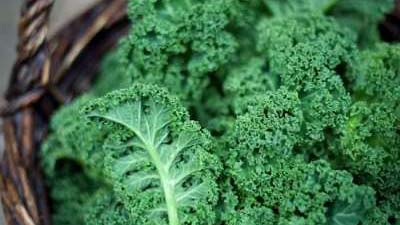How to Grow Kale in Your Garden

Summary
Kale is a cool season vegetable that prefers a sunny location and fertile, well-drained soil. Incorporate plenty of organic matter and a complete fertilizer into the area before planting. Plant seeds ¼-½ inch deep. Thin seedlings or transplant kale 12-18 inches apart in the row with rows 2 feet apart. Plant out 4-5 weeks before the last frost. Kale tastes best when plants grow rapidly and mature before the heat of summer or after fall frosts occur. Avoid water or fertilizer stress during growth. Irrigation should be deep and infrequent. Control insects and diseases throughout the year. Harvest kale when the leaves reach full size.
Recommended Kale Varieties
There are many good kale varieties for sale in local gardening outlets, on-line and through seed catalogs. Most grow well in Utah. Starbor (green; 55 days), Red Russian (purple; 50 days), and Scarlet (redleaf; 55 days) have excellent production, eating quality and cold hardiness.
How to Grow Kale
Soils
Kale prefers fertile, well-drained soil rich in organic matter for best growth. Most soils in Utah are suitable for kale production.
Soil Preparation
Before planting, determine fertilizer needs with a soil test and then follow the recommendations given with the test report. If fertilizer applications are warranted, work the fertilizer into the top 6 inches of soil. If you fertilize with compost, apply no more than 1 inch of well-composted organic matter per 100 square feet of garden area.
Plants
Kale can be grown from seed or transplants. Seeds should be planted ¼-½ inch deep and thinned when plants have 3-4 true leaves. Plants removed at thinning can be transplanted to adjacent areas. Transplants are used to provide earlier harvest. Transplants should have 4-6 mature leaves and a well-developed root system before planting. Generally 5-6 weeks are required to grow transplants to this size.
Planting and Spacing
Seeded or transplanted kale should be spaced 12 inches between plants in the row with rows 2 feet apart. Kale grows best when temperatures do not exceed 75°F. Young plants are not seriously damaged by temperatures down to 25°F. Mature plants are extremely hardy and can withstand very cold temperatures. Transplants should be planted 4-5 weeks before the last frost free date for the growing area. Seeded kale may be planted at the same time. For fall kale, select early maturing cultivars and plant 50-75 days before the anticipated maturity date. The maturity date should be about 2-3 weeks after the first fall frost. Plants can be left in the garden throughout the winter to supply greens out of season. High summer temperatures reduce growth, decrease quality, and cause bitter or off flavors to develop.
Water
Water kale deeply and infrequently while trying to maintain even soil moisture. About 1-2 inches of water are required per week. Use drip irrigation if possible to conserve water. Applying mulch around the plant also helps conserve soil moisture and reduce weed growth. Moisture fluctuations will cause leaves to become tough and develop off flavors.
Fertilization
Apply ½ cup per 10 feet of row of a nitrogen-based fertilizer (21-0-0) 4 weeks after transplanting or thinning to encourage rapid plant growth. Place the fertilizer 6 inches to the side of the plants and irrigate it into the soil.
Mulches and Row Covers
Plastic mulches help conserve water, reduce weed growth and allow earlier planting and maturity, especially with transplants. Fabric covers are used to protect seedlings and transplants from frosts and insect pests. Apply organic mulches when temperatures increase above 80°F. Organic mulches such as grass clippings, straw, and shredded newspaper help cool the soil, reduce water stress and help control weeds.
Problems with Growing Kale
Weeds
Plastic and organic mulches effectively control weeds. Be sure to control weeds when plants are small and be careful not to damage roots when cultivating.
Insects and Disease
View more detailed information on cole crop insects and diseases (PDF).
| Insect | Identification | Control |
|---|---|---|
| Aphids | Green or black soft-bodied insects that feed on underside of leaves. Leaves become crinkled and curled. | Use insecticidal soaps, appropriate insecticides, or strong water stream to dislodge insects. |
| Cabbage Worms and Loopers | Worms and loopers are light to dark green. Adult loopers are gray or brown moths while cabbage worms are white butterflies. Worms and loopers chew holes in leaves and hide in kale heads. | Control worms and loopers with appropriate insecticides or biological measures. |
| Flea Beetles | Small black beetles that feed on seedlings. Adults chew tiny holes in cotyledons and leaves. Beetles can reduce plant stands or may kill seedlings. | Controls with appropriate insecticides at seeding or after seedlings have emerged from the soil. |
How to Harvest and Store Kale
Kale should be harvested when the leaves reach full size. Older leaves are generally stripped off the plants first allowing the young leaves to continue to grow. Frosts help improve the flavor of the fall planted crop. Kale can be stored for 2-3 weeks at 32°F and 95% relative humidity. Many gardeners leave kale growing in the garden throughout the winter.
Kale Plant Productivity
Plant 5-10 feet of kale per person for fresh use and an additional 15-20 for processing. Expect 3-5 pounds per 10 feet of row.
Kale Nutrition Facts
Kale has no fat, is high in vitamin A and vitamin C, is a good source of calcium and iron and is considered one of the most nutritious of vegetables.
Published March 2020
Utah State University Extension
Peer-reviewed fact sheet
Download PDF
Authors
Dan Drost and Michael Johnson, Vegetable Specialists
Related Research







